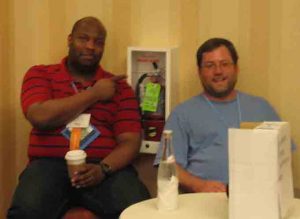This article is more than 5 years old.
OK, by now you’re probably getting tired or bored with NASIG, so for my last post I’ll try to give you the short version.
First, evidence that Chris and Steve really were there …
Saturday’s opening session was by Dr. Carol Tenopir of the Univ. of Tennessee School of Information Sciences, who discussed her research on calculating return on investment for library expenditures with respect to research/grant funding.Her research is based on surveys of university faculty, asking, for example, how important citations are to obtaining funding, and what percentage of their citations do they find via online library resources.It was an interesting methodology.
Next I went to a session where three librarians talked about their respective experiences with implementing various Pay-Per-View (PPV) products.This was a very interesting and helpful session.The only products that received favorable reviews from the panelists were Science Direct (at Trinity) and EBL (at U.Texas).Common problems with PPV products included the inability to block PPV access to content subscribed to elsewhere, cumbersome user registration, and a “shopping cart” interface that tended to scare away users.I was glad to hear the U.Texas librarian describe their EBL pilot launch as “extraordinarily successful.”
My final Saturday session was a panel discussion with 3 librarians and 2 publisher reps about the process of license negotiation-top concerns/risks, difficult points to negotiate, whether the licensing process is improving (all agreed it is not), and whether licenses are doing what they were intended to do.There was discussion about how to improve some of the inefficiencies in the process (including a new standard, ONIX-PL), and whether it might be feasible to abandon license agreements and rely instead on copyright law.Another very good discussion, and I’m glad I had the background of the preconference to give me some context.
The first two Sunday sessions were kind of disappointing; I won’t bore you with the details.The final plenary session was about identifying trustworthy content online.Geoffrey Bilder of CrossRef talked about how we judge credibility of print resources (title page, publisher blurb, cover art, trust of the library, etc.); think about how you can tell at a glance whether an article is from a popular magazine or a scholarly journal.He then pointed out that the relatively quick evaluation we can do with print resources doesn’t work well in the online world.He batted around some ideas for making it easier to judge the credibility of online resources, including CrossMark, which is being developed by CrossRef.Another one is Hon Code which, if I understood correctly, is a registry of websites, with a Firefox plugin that displays an icon when a user visits a registered site.
Overall an excellent conference.I’m afraid I’ve come away with more ideas than I know what to do with at this point.But that’s good, right?

4 Comments on ‘NASIG 2009 – Saturday & Sunday’
Yes, that’s good! Thanks for blogging the conference so diligently, Derrik!
Regarding the photo: Was Chris trying to indicate that he and Steve spent the entire conference putting out fires?? 🙂
Thanks for reporting for us.
Did they give any practical tips for paying for an “extraordinarily successful” experience with EBL PPV? 😉
They do not allow downloads (local customization), and views/rentals are unmediated. A 4th view automatically triggers a purchase. Purchases over $50 are vetted by a librarian. Estimated cost per use is about $4/book.
Derrik